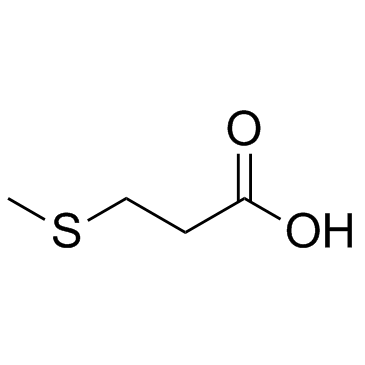3-(Methylthio)propionic acid (3-Methylsulfanylpropionic acid) |
| Catalog No.GC32943 |
3-(Methylthio)propionic acid (3-Methylsulfanylpropionic acid) is an intermediate in the methionine metabolism.
Products are for research use only. Not for human use. We do not sell to patients.

Cas No.: 646-01-5
Sample solution is provided at 25 µL, 10mM.
3-(Methylthio)propionic acid is an intermediate in the methionine metabolism.
Methionine has consistently been shown to be the most toxic amino acid in experiments devised to assess the relative toxicity of dietary amino acids. 3-methylthiopropionate is an intermediate in methionine catabolism in rat and monkey liver in vitro. This pathway appears to account for a major portion of methionine oxidation in vitro[1]. Cultures of Streptomyces lincolnensis accumulated 3-methylthioacrylic acid in amounts directly related to the concentration of methionine in the medium. The first intermediate in the pathway may be the keto acid, which is then oxidatively decarboxylated to 3-methylthiopropionic acid[2]. The purified 3-MTPA has antifungal activity in assays using F. oxysporum as a model fungus. Daily measurements of shoot and root length shows severe inhibition of seed germination and root and shoot development at concentrations above 12mg for partially purified extracts[3]. 3-methylthiopropionic acid ethyl ester possesses potential anticarcinogenic properties by inducing differentiation in well-differentiated colon cancer cells. Treatment of RCM-1 cells for 4 days with 3-methylthiopropionic acid ethyl ester between the doses of 0.25 and 2 mM progressively increases the percent area occupied by duct structures relative to the control, and also induces an increase in the number and the maximum diameter of the ducts in each culture plate[4].
[1]. Steele RD, et al. Identification of 3-methylthiopropionic acid as an intermediate in mammalian methioninemetabolism in vitro. J Biol Chem. 1978 Nov 10;253(21):7844-50. [2]. Surette R, et al. Formation of 3-methylthioacrylic acid from methionine by Streptomyces lincolnensis. Isolation of a peroxidase. J Antibiot (Tokyo). 1976 Jun;29(6):646-52. [3]. Kim YC, et al. 3-methylthiopropanoic acid produced by Enterobacter intermedium 60-2G inhibits fungal growth and weed seedling development. J Antibiot (Tokyo). 2003 Feb;56(2):177-80. [4]. Nakamura Y, et al. 3-Methylthiopropionic acid ethyl ester, isolated from Katsura-uri (Japanese pickling melon, Cucumis melo var. conomon), enhanced differentiation in human colon cancer cells. J Agric Food Chem. 2008 May 14;56(9):2977-84.
Average Rating: 5 (Based on Reviews and 12 reference(s) in Google Scholar.)
GLPBIO products are for RESEARCH USE ONLY. Please make sure your review or question is research based.
Required fields are marked with *




















